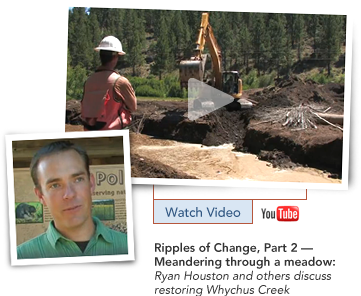Because of the degree to which some streams in the Deschutes Basin have been changed, many channels do not provide adequate conditions for fish even if they are unblocked. In much of the upper watershed, factors such as channelization and erosion have degraded habitat conditions. Migratory fish require a surprisingly high diversity of habitats for their numerous life stages, including gravel-bottom riffles, calm backwaters, side channels, and deep pools with cover and sunken debris to hide in.
Because of the complex habitat requirements of the Deschutes River fish population, Houston estimates that about half the funds spent on improvements in the upper Deschutes will be spent on habitat restoration and enhancement projects.
On Whychus Creek, local groups are undertaking several restoration projects to return some of this necessary habitat diversity. The largest project is being undertaken at Camp Polk Meadows, a 145-acre preserve owned by the Deschutes Basin Land Trust. In the summer of 2009, the Land Trust partnered with the Upper Deschutes Watershed Council to begin the $1.4 million restoration project.
The plan’s goal is to return the Whychus Creek to the meandering course it took before the U.S. Army Corp of Engineers channelized its flow in the 1960s. The project involves the construction of a 1.7 mile channel, restoring wetlands, and planting 150,000 individual native plants. The project aims to provide fish spawning and rearing habitat, reduce stream temperature, and increase late season flow.
Even though Whychus Creek has changed over the years – arguably not for the better – the creek is still a special place for many people. Martin Winch, who volunteers for the Deschutes Basin Land Trust, became so enamored with Camp Polk Meadows that he used it as the subject of his book. Called Biography of a Place, the book describes the history of Central Oregon through the characters that are drawn to the meadow, including Native Americans, trappers, soldiers and settlers.
In the book, each successive generation had a new and different perspective about the meadow: Native Americans once knew the meadows as a seasonal camping and gathering place, but modern agency engineers worried about the creek’s potential for destructive floods.
Winch sees the restoration efforts as the latest chapter in the narrative of Whychus Creek, and the result of renewed enthusiasm for protecting Deschutes Basin streams. “The hydrologists are really the last players,” Winch says. “No one is going to invite them in and support a project or even conceive of it until people come to relate and care.”

